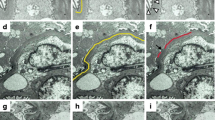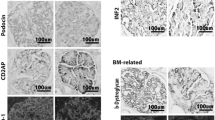Abstract
Our aim was to correlate an immunohistochemical pattern of selected podocyte cytoskeleton-associated proteins in children diagnosed with focal segmental glomerulosclerosis (FSGS) and diffuse mesangial proliferation accompanied by glomerular immaturity (Im-DMP) with the clinical courses of both diseases. The material included 33 renal biopsies obtained from children diagnosed with DMP with or without signs of glomerular immaturity (ten and 15 participants, respectively) or FSGS (eight patients). Ezrin, podocalyxin, synaptopodin and nephrin expression was evaluated by immunohistochemical assay. A positive reaction for ezrin, podocalyxin, synaptopodin and nephrin was observed in the most superficial, continuous ‘layer’ of podocytes in Im-DMP patients. This distribution closely mimicked the immunohistochemical pattern observed in FSGS. The severe initial course of Im-DMP was transient. Resistance to steroids (six children) and renal insufficiency (two patients) in these subjects subsided, whilst, in the FSGS patients, the resistance to steroids recognized in all the children and the renal insufficiency diagnosed in three of them were still present. Mimicry between the immunohistochemical pattern of glomerular immaturity in DMP and focal segmental glomerulosclerosis might explain the severe initial course of this nephrotic syndrome in children. The transient clinical character of the former may also indicate that it is not a variant of FSGS.



Similar content being viewed by others
Notes
Parts of this investigation were reported at the IVth Conference of the Polish Association of Paediatric Nephrology in Cracow, Poland, 20–22 April 2006, published in [20].
References
White RHR, Glasgow EF, Mills RJ (1970) Clinicopathological study of nephrotic syndrome in childhood. Lancet 1:1353–1358
Waldherr R, Gubler MC, Levy M, Broyer M, Habib R (1978) The significance of pure diffuse mesangial proliferation in idiopathic nephrotic syndrome. Clin Nephrol 10:171–179
Fogo AB, Kashgarian M (2005) Diagnostic atlas of renal pathology. A companion to Brenner & Rector’s The Kidney 7th edition. Elsevier Saunders, London, pp 27–29
Ostalska-Nowicka D, Zachwieja J, Maciejewski J, Wozniak A, Salwa-Zurawska W (2004) The prognostic value of glomerular immaturity in the nephrotic syndrome in children. Pediatr Nephrol 19:633–637
Oh J, Reiser J, Mundel P (2004) Dynamic (re)organization of the podocyte actin cytoskeleton in the nephrotic syndrome. Pediatr Nephrol 19:130–137
Endlich K, Kriz W, Witzgall R (2001) Update in podocyte biology. Curr Opin Nephrol Hypertens 10:331–340
Turunen O, Wahlstrom T, Vaheri A (1994) Ezrin has a COOH-terminal actin-binding site that is conserved in the ezrin protein family. J Cell Biol 126:1445–1453
Hugo C, Nangaku M, Shankland SJ, Pichler R, Gordon K, Amieva MR, Couser WG, Furthmayr H, Johnson RJ (1998) The plasma membrane-actin linking protein, ezrin, is a glomerular epithelial cell marker in glomerulogenesis, in the adult kidney and in glomerular injury. Kidney Int 54:1934–1944
Takeda T, Go WY, Orlando RA, Farquhar MG (2000) Expression of podocalyxin inhibits cell–cell adhesion and modifies junctional properties in Median Darby canine kidney cells. Mol Biol Cell 11:3219–3232
Horvat R, Hovorka A, Dekan G, Poczewski H, Kerjaschki D (1986) Endothelial cell membranes contain podocalyxin: the major sialoprotein of visceral glomerular epithelial cells. J Cell Biol 102:486–491
Mundel P, Heid HW, Mundel TM, Kruger M, Reiser J, Kriz W (1997) Synaptopodin: an actin associated protein in telencephalic dendrites and renal podocytes. J Cell Biol 139:193–204
Ruotsalainen V, Ljungberg P, Wartiovaara J, Lenkkeri U, Kestila M, Jalanko H, Holmberg C, Tryggvason K (1999) Nephrin is specifically located at the slit diaphragm of glomerular podocytes. Proc Natl Acad Sci USA 96:7962–7967
Holmberg C, Olsen A, Tryggvason K (1998) Positionally cloned gene for a novel glomerular protein-nephrin is mutated in congenital nephrotic syndrome PG -575-82. Mol Cell 1:575–582
Ruotsalainen V, Patrakka J, Tissari P, Reponen P, Hess M, Kestila M, Holmberg C, Salonen R, Heikinheimo M, Wartiovaara J, Tryggvason K, Jalanko H (2000) Role of nephrin in cell junction formation in human nephrogenesis. Am J Pathol 157:1905– 1916
Gulati S, Sharma AP, Sharma RK, Gupta A, Gupta RK (2002) Do current recommendations for kidney biopsy in nephrotic syndrome need modifications? Pediatr Nephrol 17:404–408
Hsu S, Raine L, Tanger H (1981) Use of avidin–biotin peroxidase complex (ABC) and unlabeled antibody (PAP) procedures. J Histochem Cytochem 29:577–580
Armitage P (1978) Statistical methods in medical investigations (in Polish), 1st edn. PZWL, Warszawa, pp 97–103
Ostalska-Nowicka D, Zachwieja J, Nowicki M, Kaczmarek E, Siwinska A, Witt M (2005) Vascular endothelial growth factor (VEGF-C1)-dependent inflammatory response of podocytes in nephrotic syndrome glomerulopathies in children: an immunohistochemical approach. Histopathology 46:176–183
Ostalska-Nowicka D, Zachwieja J, Nowicki M, Kaczmarek E, Siwinska A, Witt M (2006) Ezrin—a useful factor in the prognosis of nephrotic syndrome in children: an immunohistochemical approach. J Clin Pathol 59:916–920
Ostalska-Nowicka D, Zachwieja J, Nowicki M, Siwinska A, Wozniak A (2006) Immunohistochemical analysis of podocytopathy with immature glomeruli and glomerulosclerosis in children with nephrotic syndrome. Przegl Lek 63:97–100
Schmieder S, Nagai M, Orlando RA, Takeda T, Farquhar MG (2004) Podocalyxin activates RhoA and induces actin reorganization through NHERF1 and ezrin in MDCK cells. J Am Soc Nephrol 15:2289–2298
Srivastava T, Garola RE, Whiting JM, Alon US (2001) Synaptopodin expression in idiopathic nephrotic syndrome of childhood. Kidney Int 59:118–125
Barratt TM, Clark G (1994) Minimal change nephrotic syndrome and focal segmental glomerulosclerosis. In: Holliday MA, Barratt TM, Avner ED (eds). Pediatric nephrology, 3rd edn. Wiliams & Wilkins, Baltimore, pp 767–787
Coimbra TM, Janssen U, Grone HJ, Ostendorf T, Kunter U, Schmidt H, Brabant G, Floege J (2000) Early events leading to renal injury in obese Zucker (fatty) rats with type II diabetes. Kidney Int 57:167–182
Meyer TW, Bennet PH, Nelson RG (1999) Podocyte number predicts long-term urinary albumin excretion in Pima Indians with type II diabetes and microalbuminuria. Diabetologia 42:1341–1344
Ostalska-Nowicka D, Zachwieja J, Nowicki M, Witt M (2004) Expression of intermediate filaments of podocytes within nephrotic syndrome glomerulopathies in children. Histochem Cell Biol 121:109–113
Acknowledgements
We are indebted to Mrs. S. Bramke and Mrs. A. Neisser, University of Technology Dresden, Germany, for their skilful technical work, to Dr. M. G. Farquhar, San Diego, CA, USA, for the generous donation of the podocalyxin antibody, and to Prof. G. Shaw for his assistance with the English text. This study was supported by the State Committee for Scientific Research (KBN, grant no. 2PO5E 07130).
Author information
Authors and Affiliations
Corresponding author
Rights and permissions
About this article
Cite this article
Ostalska-Nowicka, D., Zachwieja, J., Nowicki, M. et al. Is mesangial hypercellularity with glomerular immaturity a variant of glomerulosclerosis?. Pediatr Nephrol 22, 674–683 (2007). https://doi.org/10.1007/s00467-006-0407-9
Received:
Revised:
Accepted:
Published:
Issue Date:
DOI: https://doi.org/10.1007/s00467-006-0407-9




